Scenes from Anglo-French history, 1204-59
The chronicles of Matthew Paris (d.1259), a monk of Saint Albans Abbey, are some of the best-known
sources for medieval English history. His illustrations in his Chronica Majora vividly depicted
many events in the history of England and France in the first half of the thirteenth century.
A selection of them is reproduced here, with the kind permission of the Master and Fellows of
Corpus Christi College, Cambridge.
(Visit the Parker Library website.)

|
|
The battle of Bouvines (1214).
Philip Augustus, king of France, lies unhorsed (left), while the Picard knight
Hugh de Boves, one of the commanders of the defeated Anglo-Imperial forces,
flees (right). The battle ruined the chances of King John (who was not present)
to recover his lost French possessions and allowed the king of France to secure
his grip upon Normandy and Anjou.
Matthew Paris, Chronica Majora, II, fol. 37r (41r). Reproduced by permission of the Master and Fellows of Corpus Christi College, Cambridge.
(Visit the Parker Library website.)
|

|
|
The shipwreck of Hugh de Boves (1215).
Hugh de Boves, a brother of the lord of Boves in Picardy, was one of numerous northern
French lords whose career spanned both sides of the English Channel after 1204. When
he and his force of French mercenaries drowned off the Suffolk coast in September 1215,
it greatly weakened King John's position at the outbreak of the Magna Carta civil war.
Although the English Channel and North Sea were busy sea routes in the Anglo-Norman era,
crossing from England to the Continent remained a hazardous enterprise.
Matthew Paris, Chronica Majora, II, fol. 42v (46v). Reproduced by permission of the Master and Fellows of Corpus Christi College, Cambridge. (Visit the Parker Library website.)
|
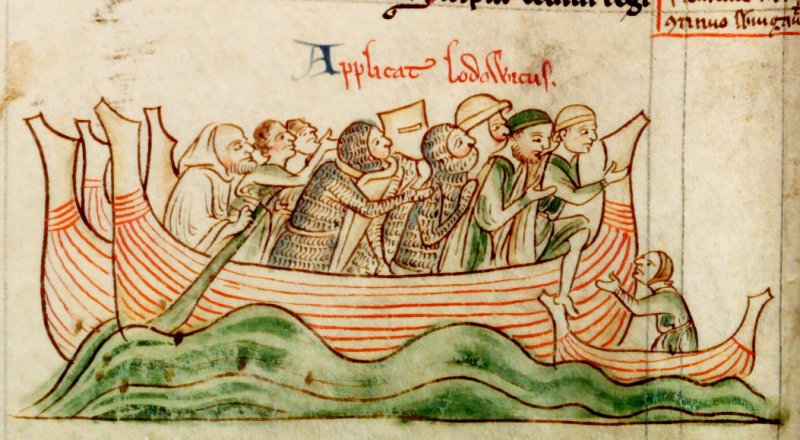
|
|
Arrival of Louis of France in England (1216)
Louis (later King Louis VIII), son and heir of King Philip II Augustus of France, crosses the Channel to support the great English rebellion against King John and claim the English throne. For a time it looked as if England and Normandy might be reunited, under the Capetian dynasty of French kings.
Matthew Paris, Chronica Majora, II, fol. 46v (50v). Reproduced by permission of the Master and Fellows of Corpus Christi College, Cambridge. (Visit the Parker Library website.)
|
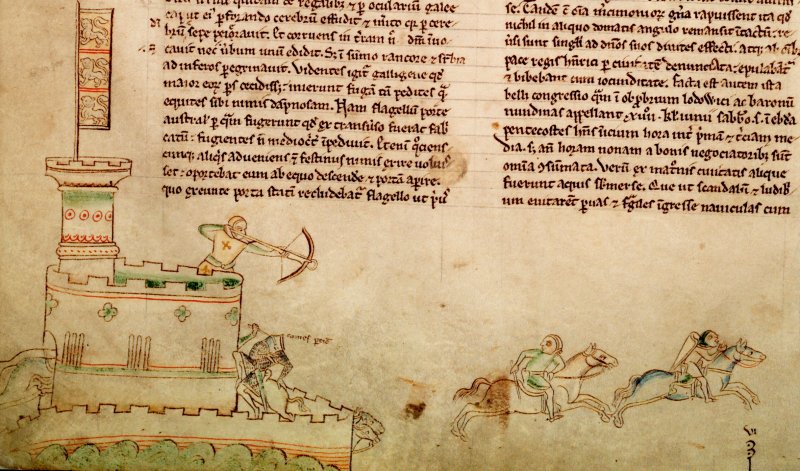
|
|
The battle of Lincoln (1217)
The royalist victory at Lincoln over the English rebels and their French allies
was a major blow to the hopes of Louis of France of becoming king of England.
The most prominent casualty was Count Thomas of Perche, whose death is depicted
here; he had come to England to seek to recover the honour of Perche, lost by
his mother (a niece of King John) in 1204, and including Newbury and Shrivenham
(Berks), Toddington (Bucks), and Haughley (Suffolk).
Matthew Paris, Chronica Majora, II, fol. 51v (55v). Reproduced by permission of the Master and Fellows of Corpus Christi College, Cambridge. (Visit the Parker Library website.)
|

|
|
The battle of Sandwich (1217)
This English naval victory against the French ended Louis' bid for the English throne. The pirate Eustace the Monk, whose death is depicted here, was a key figure in relations between England and Normandy in the years after 1204, fighting at different times for both King John and Philip Augustus and pillaging the coasts of both England and Normandy.
Matthew Paris, Chronica Majora, II, fol. 52r (56r). Reproduced by permission of the Master and Fellows of Corpus Christi College, Cambridge. (Visit the Parker Library website.)
|
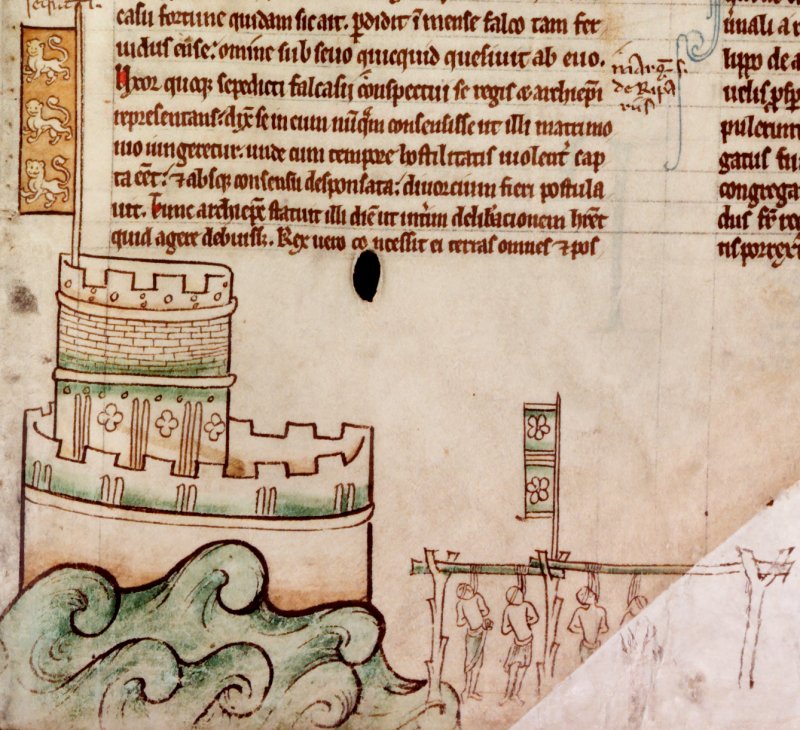
|
|
The siege of Bedford Castle and the execution of its garrison (1224)
The Norman knight Falkes de Bréauté became a powerful military commander and official under King John, governing several Midland counties. In 1224, however, he was driven to revolt at Bedford by the hostility of the regency government of the young Henry III and the garrison, who included his brother William and a number of knights from Normandy, were executed when the castle fell to the royal army. The siege of Bedford inadvertently helped Louis VIII to overrun Henry's lands in Poitou.
Matthew Paris, Chronica Majora, II, fol. 60(64r). Reproduced by permission of the Master and Fellows of Corpus Christi College, Cambridge. (Visit the Parker Library website.)
|

|
|
Henry III sails to Brittany (1230)
In 1230 Henry III made his first attempt to recover the French lands lost by his father King John in 1204. He landed in Brittany and he seriously considered invading Normandy, but decided to head south towards Poitou instead. His expedition was a lamentable failure.
Matthew Paris, Chronica Majora, II, fol. 75v(79v). Reproduced by permission of the Master and Fellows of Corpus Christi College, Cambridge. (Visit the Parker Library website.)
|
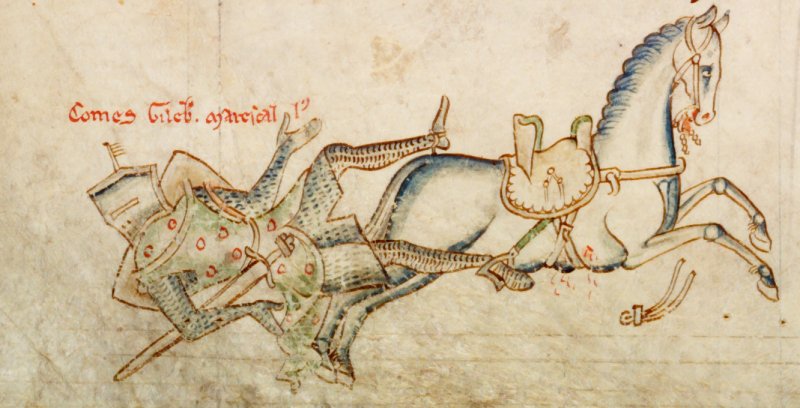
|
|
Death of Gilbert Marshal, earl of Pembroke, in a tournament (1241)
Gilbert, third son of the great William Marshal and Isabella of Chepstow (daughter of Richard 'Strongbow', the most famous of the Anglo-Norman invaders of Ireland), had been trained for an ecclesiastical career, but the deaths of his older brothers William II Marshal (1231) and Richard Marshal (1234), earls of Pembroke, meant that he inherited the vast Marshal estates in England, Wales and Ireland. He hoped to recover the lost Marshal lordships of Longueville and Orbec in Normandy but they remained in the hands of the king of France.
Matthew Paris, Chronica Majora, II, fol. 147v(148v). Reproduced by permission of the Master and Fellows of Corpus Christi College, Cambridge. (Visit the Parker Library website.)
|
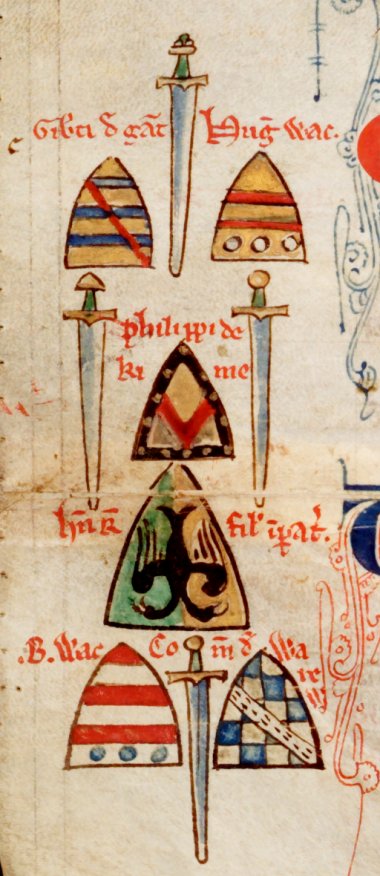
|
|
Inverted shields indicating the deaths in 1242 of numerous English barons (as well as the eldest son of the Holy Roman Emperor).
The deceased include Hugh Wake of Bourne (Lincs.) and his son Baldwin, whose family had lost lands near Bayeux in 1204.
Hugh had also inherited half the manor of Winchendon (Bucks), the dowry of his grandmother Agnes du Hommet;
Agnes' inheritance of the manor meant that it was not confiscated with the other Hommet lands in England in 1204.
The coats-of-arms depicted in this illustration are a reminder of the importance of heraldry for the European aristocracy by the 13th century.
Matthew Paris, Chronica Majora, II, fol. 155v (156v). Reproduced by permission of the Master and Fellows of Corpus Christi College, Cambridge. (Visit the Parker Library website.)
|
|
![Battle of Bouvines and the flight of Hugh de Boves (1214). MS 16, f 37r[41]r.
Reproduced by permission of the Master and Fellows of Corpus Christi College, Cambridge. Battle of Bouvines and the flight of Hugh de Boves (1214). MS 16, f 37r[41]r.
Reproduced by permission of the Master and Fellows of Corpus Christi College, Cambridge.](images/cc-ms16f37r-HughdeBoves-480x143.gif)
![Battle of Bouvines and the flight of Hugh de Boves (1214). MS 16, f 37r[41]r.
Reproduced by permission of the Master and Fellows of Corpus Christi College, Cambridge. Battle of Bouvines and the flight of Hugh de Boves (1214). MS 16, f 37r[41]r.
Reproduced by permission of the Master and Fellows of Corpus Christi College, Cambridge.](images/cc-ms16f37r-HughdeBoves-480x143.gif)